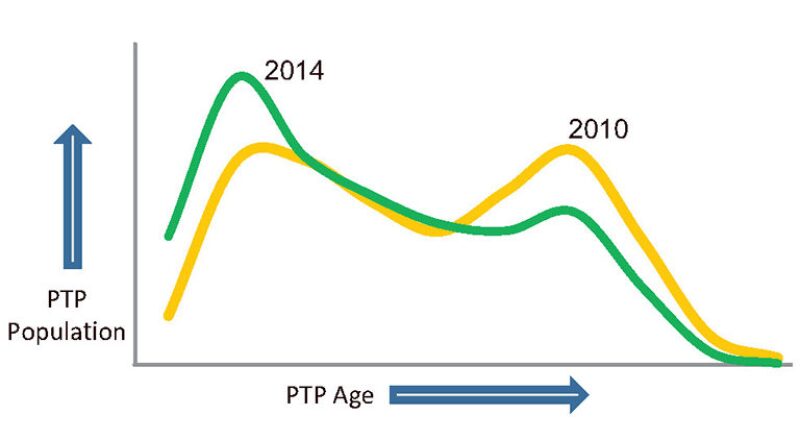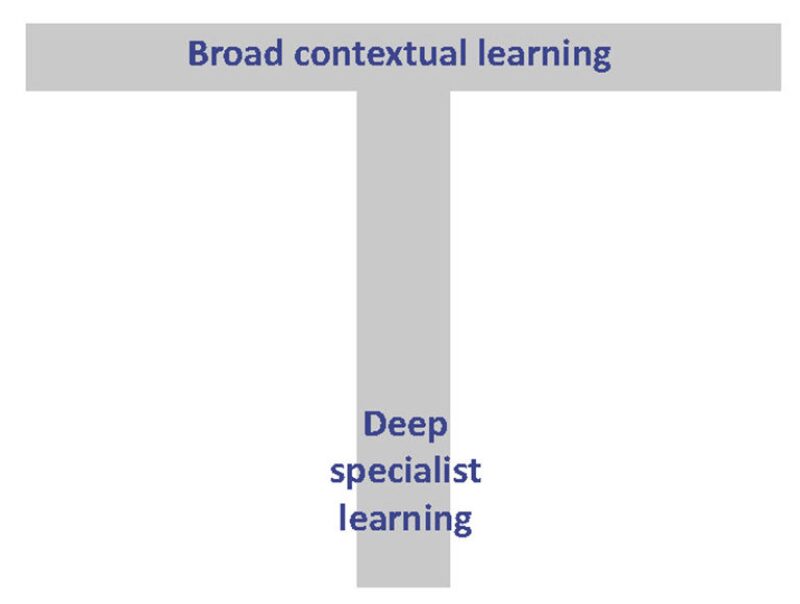The continued search for oil and gas relies in equal measure on good management and superior petrotechnical expertise. The key is ensuring that the two worlds mesh smoothly and create a working environment that motivates both parties to succeed. This is less obviously achieved than might be thought for a number of factors.
First is the scarcity of top-quality petrotechnical professionals (Fig. 1). This used to be blamed on the famous “crew change,” which described the paucity of recruits during the oil price crash of the 1980s. But things have now changed. The past few years have seen abundant recruiting by both operators and the service industry, and the crew change problem has morphed into the challenge of accelerating the development of thousands of young professionals to fill the still prevalent mid-career gap. The result is an industry obsessed with accelerating employee development.

Second is the market force generated by the continued lack of mid-career petrotechnical professionals. These lucky individuals command a price in excess of their equivalent managers, and so even do the young aspirants joining their ranks. With the oil price robust around USD 100/bbl and global upstream activity buoyant, there remains an extraordinary lack of competent geoscientists, drilling engineers, and petroleum engineers. And they know it. Never has it been so easy to jump ship, hoping for a better future.
Third is the meeting point between management and the petrotechnical expert. Both obviously aspire to business success, but beneath broad corporate goals lurk important differences. In companies of any reasonable size, managements must ensure that their machine to find and extract oil and gas is properly assembled, well lubricated, and working to maximum efficiency. Standards and discipline are important; within well-defined limits, employees are expected to conform.
The technical expert, however, marches to a different tune, motivated by quite different criteria. When it comes to creativity and improving technical knowledge, petrotechnical professionals prefer less rather than more management, or even no management. The ideal state is being self-directed; satisfaction comes from solving tough technical problems. When it comes to their career, peer recognition and involvement is as important as management input. In short and at risk of working an analogy beyond breaking point, the square peg that is the technical expert may not always fit the round holes of the smooth-running business machine. How to manage this less-than-exact fit requires some unusual strategies.
Let’s start with two management imperatives and then examine the details (Fig. 2).
First, in order to keep pace, managers need the brightest and best informed technical experts possible. This means ensuring technical employees have the right environment to develop new knowledge and skills, particularly in emerging technology areas, and not necessarily junior employees only. It also means that experts need free and easy exchange of knowledge and experience both from within and outside the company firewall.
Second, management needs to incentivize their technical experts not to leave for more enticing-looking employers. This can be achieved through a smorgasbord of options, including total compensation package, a technical promotion system or ladder, and satisfying the development needs mentioned above. Above all, management must provide strong leadership and ensure a coherent and attractive company culture.
Employee Development
Employee development is easy to wish for, harder to put into practice. There are several pitfalls. One is the traditional thinking that development is going on a weeklong training course once a year. Courses have their place, but are only one component of a development program. The other components include self-study—used to be done from books but now the Internet—on-the-job training, just like apprentices used to do, and learning from colleagues. Each training mode has its memory retention factor, and research shows that the classroom setting, although a key for getting basics across, does not rank high compared with self-study and repetitive hands-on experience.
Whatever the mix, two management temptations must be discouraged. The first is cutting employee training whenever business looks bleak. It is the easiest thing to cut since it never impacts the short-term bottom line, but the long term is another matter. The second is believing that the return on investment of training and development can be measured and monitored. Training and development, by definition, is a long-term commitment, and it is as hard to quantify the benefits as it is to predict the success of R&D.

What management can insist on is focusing training and development on the job at hand, or at least what the employee is likely to be doing in the near future. Otherwise, training budgets quickly get eaten up, providing employees nice-to-know stuff rather than need-to-know essentials. The challenge is deciding what is truly necessary for the business. The oft-quoted T-model of training and development is a useful metaphor (Fig. 3). The vertical of the T represents in-depth specialist expertise, while the horizontal represents broad contextual understanding. How a company trains its employees depends very much on the importance attached to each at various stages of the technical expert’s career.
Companies wishing to realize immediate earning power from young employees will focus on the vertical, allowing the horizontal to develop once the employee matures. Other companies prefer more contextual development before forcing the vertical. It is a matter of strategy, but it needs to be thought through.
There are concomitant choices for managing the employee’s development. The vertical is best managed through curriculum-based programs, a linear progression of tasks and learnings to be checked off. The horizontal is best managed using a competency management approach that maps selected competencies and proficiencies to the job at hand. It risks becoming a large sledge hammer to crack the nut, but the idea does offer flexibility and the option to tailor training programs to large numbers of diverse employees. However, competency management comes with a health warning. The systems quickly get heavy, require employee assessments, and are difficult to maintain. The trick is to keep things simple.
Another training imperative is coaching, an idea handed to us from ancient times when young people learned from a master. It has been unambiguously proven in recent studies that good coaching provides the most efficient catalyst for accelerating employee learning. However, most companies struggle with the same basic conundrums. The coaching role needs careful definition, otherwise it ends up meaning whatever the participants decide. It is also expensive because valuable time is required from senior technical experts, and in today’s world, there are simply not enough senior experts to go round. Some companies contract retired experts to provide the coaching, but this risks diluting company culture. Coaching is worth every penny, but there are no cookbook recipes.
Knowledge Management
Knowledge is essential for any business, not least for satisfying a technical expert’s ability to keep in touch with everything that is new. Technical knowledge in the business context can be divided between knowledge accessible from public sources and knowledge that is retained behind the firewall because it is deemed proprietary or confidential. Accessing the former is a purely mechanical task, revolutionized in the past decade by the Internet. Managing the latter is harder because the company itself must create the mechanisms. This management of internal technical knowledge is divided into two main parts.
One is explicit knowledge gained from company activities that must be validated, cataloged, and made available internally. The other is so-called tacit knowledge that is in the heads of the technical experts and only gets shared in conversation, either in person or through the intranet. Sharing tacit knowledge is primarily a social activity. It works best when there is no interference from management; they would simply get in the way. The challenge for most companies is stretching the culture enough so employees can share their tacit knowledge with zero control. When it began, this type of activity was called communities of practice, but what it has become is just a typical social media activity such as Linked-In or Facebook, but restricted inside the company.
Incentivization and Careers

Given the continued shortfall in experienced petrotechnical professionals, both operators and the service industry are fighting for talent. For the professionals, the money offered can be tempting and occasionally extravagant, to the point where it is impossible for any company to compete on an ongoing basis. What companies can do, however, is to ensure that their employees understand the total remuneration package, comprising salary, bonus, housing and travel benefits, pension, and so on. The details are rarely understood by the employee or even enumerated by the employer. But the analysis is worth it, because it is the only way the employee can make a long-term comparison with offers on hand (Fig. 4).
The best incentive for petrotechnical professionals is a good career. Time and again, studies have shown that employees jump ship because of career dissatisfaction. This covers a multitude of sins, but a few basics cannot be argued with.
One is the need for status within the company. The company, in which the management line remains the only path to the top, risks losing its technical talent. The company with a secure technical ladder tied to a well-defined compensation scale will have no such worries. But given the number of failed attempts in our industry, the question is how to create a technical ladder that both management and the petrotechnical professionals believe in. Two issues are key: the ladder must be jointly owned and managed by both management and the technical community, and the criteria for a technical promotion must address in equal part both business needs and technical requirements.
Another basic is the well-known fact that many employees quit because they can no longer tolerate their boss or some other irritant close by. This is hard for management to pick up on, but can be avoided by careful monitoring of employee dissatisfaction. In the last analysis, the employee is as responsible for his or her career as the employer is. Both make choices. The challenge is to create the best possible dialogue.
A New Contract
The oil and gas business continues on its technology journey and petrotechnical professionals provide the know-how. But they will remain in short supply for at least another decade. In the main, managers and technical professionals are cut from a different cloth, so a company’s prerogative is to ensure that their respective talents compliment rather than compromise each other. Contrary to traditional practice, lot can be gained by an emphatic sharing of responsibility in key areas such as careers, training and development, knowledge management, and status for the technical professional. For the younger generation, especially, this is just plain common sense. For companies that have adopted this philosophy, it has paid huge dividends.
Henry Edmundson is a director of R9 Energy Consultants, consulting in upstream strategy, communication, and technical capability. Previously, he worked for Schlumberger. His career there spanned 46 years starting with assignments as a wireline field engineer, interpretation development engineer, and research petrophysicist. He then became the founding editor of the Schlumberger Oilfield Review and a corporate speech writer. For the past 15 years, he oversaw the development of several global programs for the company’s several thousand-strong petrotechnical professionals, including communities of practice initiative, the company’s technical ladder, and a competency-driven training and development program. He is an active member of SPE, the Society of Petrophysicists and Well Log Analysts, and the European Association of Geoscientists and Engineers. He is coauthoring a comprehensive history of upstream technology development. David Bamford retired from BP in 2003 after a 23-year career that included years as a chief geophysicist and later as head of exploration, overseeing the recruitment, development, training, and motivation of geophysicists, geoscientists, and explorers. He also recently retired from Tullow Oil after 10 years as a nonexecutive director, serving as both senior independent director and chair of the Remuneration Committee. He is now a nonexecutive director at Premier Oil. He also cofounded Finding Petroleum, an events and media company. |

